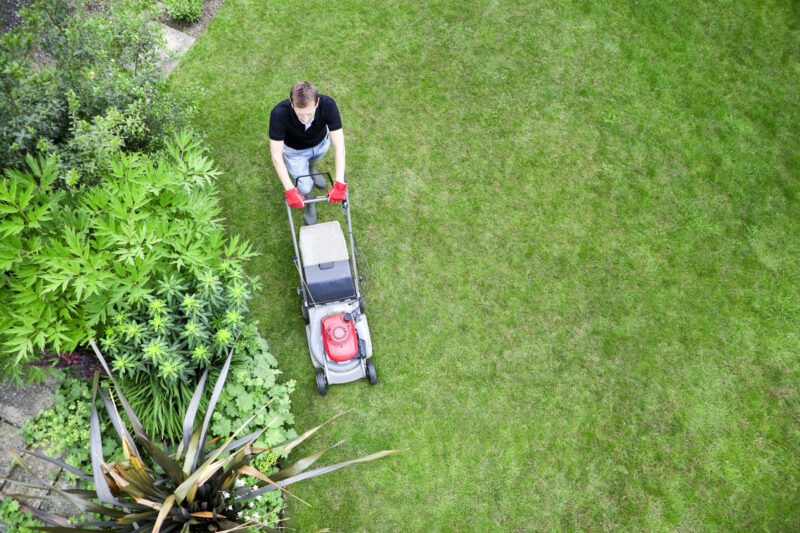Letting go of the mow

With the growing trend towards rewilding, it may be time to rethink your pristine lawn, improve your garden’s diversity and release yourself from the shackles of lawnmowing. Words & Photos Gretchen Carroll
There’s a delightful Enid Blyton story called Mr Gobo’s Green Grass. Mr Gobo makes his servant Tiny work on his pristine lawn every day and won’t let any of the villagers near it. He drives away all the insects and flowers. The townsfolk teach him a lesson by letting some moles loose on the lawn, and at the story’s end he says, “In future my lawn isn’t going to be beautiful – it’s going to be useful.”
When we moved into our house, the garden was largely lawn and took 45 minutes to mow. Now it takes 10 minutes at most. The changes we’ve made were to increase the productivity and biodiversity of our garden, while reducing time and energy expended (both ours and the planet’s).
In his book Gaia’s Garden, Toby Hemenway reports: “Our love of tidy, but not very diverse yards is imprinted on us ... The immaculate lawn was developed in the mild and evenly moist climate of Great Britain. A lawn in preindustrial times trumpeted to all that the owner possessed enough wealth to use some land for sheer ornament, instead of planting all of it to food crops. Our addiction to impeccable lawns is counter to the tendency of nature and guarantees us to constant work.”
Now there’s a growing movement towards rewilding, and thinking of different ways your garden (including your berm) can be used to greater benefit. It might not mean getting rid of all your lawn; instead, it could mean reducing it, or replacing the kind of lawn cover you have
WHAT GRETCHEN DID
Previously, our garden was largely kikuyu grass (Cenchrus clandestinus), a hardy creeping type that loves to take over. We have since largely removed and replaced it. To kill the kikuyu, we layered several layers of thick cardboard over the top, weighed down with rocks. You could use plastic sheets instead. We also did the hard graft of, as a family, ripping out patches by the roots, which was strangely cathartic. Now the grass is sitting in black plastic bags to both kill it and slowly turn it into useful compost, which will take about a year.
Once removed, we sowed Mercury Bay (Dichondra repens) ornamental lawn seed in one large section – this is best done in spring. We also built a winding stone path through this area. Mercury Bay is a soft, lush, green ground cover ideal for shady areas. It never needs to be mown; however, Kings Seeds recommends a grooming twice a year will keep it in top condition. Once established, it is divine to walk on.
In an adjacent small patch, we sowed a mix of chamomile and Mercury Bay – just make sure the chamomile is the ground cover variety, chamomile Roman (Chamaemelum nobile). The lovely thing about chamomile is it gives off a delightful fragrance when you tread on it.
In both areas, where clover pops up, we just let it mingle. Neither need mowing, so we’ve gained time while reducing costs (and the pollution from our petrol lawnmower).
In another area, we replaced the kikuyu with garden beds so that this land is more productive. We have three large vegetable beds soaking up the sun, producing leafy spinach, potatoes, radishes and lettuce (to name a few). Kikuyu is also unfriendly to tree growth, so we put in large mulched areas, which has the double benefit of eliminating the grass and supporting the trees.
Even if you’re not inflicted with kikuyu, other lawn types have the disadvantage of needing precious water in summer to keep the lawn green if it’s kept short. Short lawns have shallow roots that need feeding and watering, so letting it grow longer (or even going a bit wild) is a big help – plus, the insect life will thank you for it.
Single type lawns are also more susceptible to disease and pests. Nature relies on variety, so consider replacing single-type lawns with a mix of species. In a steep part of our garden, we sowed a wildflower seed mix. These look attractive and bring a variety of insects, including bees and butterflies, which in turn benefit the whole garden with pollination and pest management. We did the same with one section of our berm. Our chosen crimson clover (Trifolium incarnatum) attracted passer-by photographers, while the rest of the berm grass we leave long.
You might worry that no traditional lawn means no play areas for children, but we’ve found that our eight-year-old loves climbing trees, having more nature to explore and enjoying the softness of the Mercury Bay. You could simply reduce your lawn’s size rather than eliminate it completely – and if you have a park or school nearby, take the cricket set there and save yourself trips to the neighbours’ for wayward balls.
